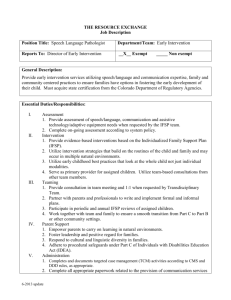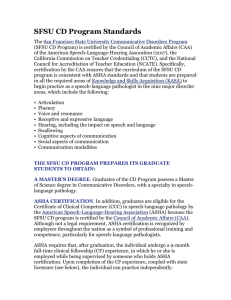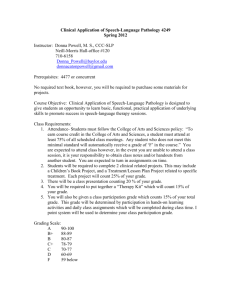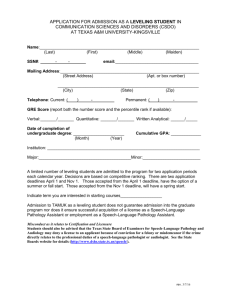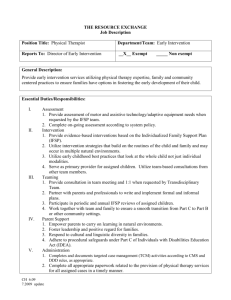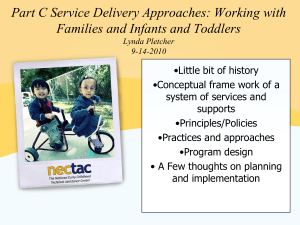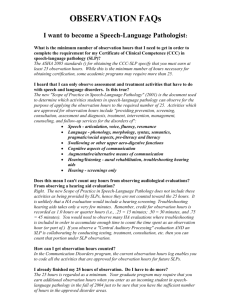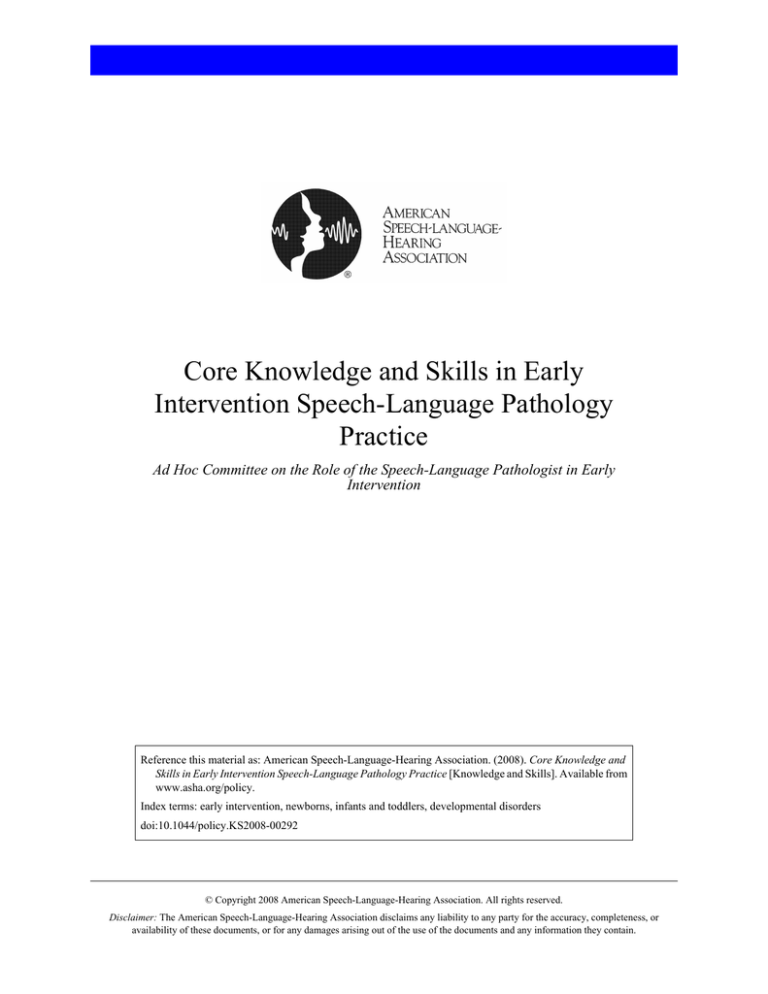
Core Knowledge and Skills in Early
Intervention Speech-Language Pathology
Practice
Ad Hoc Committee on the Role of the Speech-Language Pathologist in Early
Intervention
Reference this material as: American Speech-Language-Hearing Association. (2008). Core Knowledge and
Skills in Early Intervention Speech-Language Pathology Practice [Knowledge and Skills]. Available from
www.asha.org/policy.
Index terms: early intervention, newborns, infants and toddlers, developmental disorders
doi:10.1044/policy.KS2008-00292
© Copyright 2008 American Speech-Language-Hearing Association. All rights reserved.
Disclaimer: The American Speech-Language-Hearing Association disclaims any liability to any party for the accuracy, completeness, or
availability of these documents, or for any damages arising out of the use of the documents and any information they contain.
Core Knowledge and Skills in Early Intervention SpeechLanguage Pathology Practice
About This
Document
Knowledge and Skills
This knowledge and skills document is an official statement of the American
Speech-Language-Hearing Association (ASHA). It was developed by ASHA's Ad
Hoc Committee on the Role of the Speech-Language Pathologist in Early
Intervention. Members of the Committee were M. Jeanne Wilcox (chair), Melissa
A. Cheslock, Elizabeth R. Crais, Trudi Norman-Murch, Rhea Paul, Froma P. Roth,
Juliann J. Woods, and Diane R. Paul (ex officio). ASHA Vice Presidents for
Professional Practices in Speech-Language Pathology Celia Hooper (2003–2005)
and Brian B. Shulman (2006–2008) served as the monitoring officers. The ASHA
Scope of Practice in Speech-Language Pathology (ASHA, 2007) states that the
practice of speech-language pathology includes providing services for infants and
toddlers with communication needs. The ASHA Preferred Practice Patterns for the
Profession of Speech-Language Pathology (ASHA, 2004) are statements that
define universally applicable characteristics of practice. It is required that
individuals who practice independently in this area hold the Certificate of Clinical
Competence in Speech-Language Pathology and abide by the ASHA Code of
Ethics (ASHA, 2003), including Principle of Ethics II, Rule B, which states that
“individuals shall engage in only those aspects of the profession that are within
their competence, considering their level of education, training, and experience.”
This document was approved by the ASHA Board of Directors (BOD 4-2008) in
February 2008.
****
Roles and Guiding
Principles
This document summarizes knowledge and skills needed by speech-language
pathologists (SLPs) serving infants and toddlers. As indicated in the ASHA
document Roles and Responsibilities of Speech-Language Pathologists in Early
Intervention: Guidelines (ASHA, 2008), appropriate roles for SLPs serving infants
and toddlers include but are not limited to
1. prevention;
2. screening, evaluation, and assessment;
3. planning, implementing, and monitoring intervention;
4. consultation with and education for team members, including families and
other professionals;
5. service coordination;
6. transition planning;
7. advocacy;
8. awareness and advancement of the knowledge base in early intervention.
These roles are implemented in collaboration with families, caregivers, and other
professionals. This document delineates the specialized knowledge base and the
skills that appropriately certified and licensed SLPs are expected to have to
implement these roles in accord with the following guiding principles (ASHA,
2008):
1. Services are family centered and culturally and linguistically responsive.
2. Services are developmentally supportive and promote children's participation
in their natural environments.
3. Services are comprehensive, coordinated, and team based.
4. Services are based on the highest quality evidence that is available.
1
Core Knowledge and Skills in Early Intervention SpeechLanguage Pathology Practice
Definitions and Basic
Constructs for
Practice
Knowledge and Skills
Knowledge of
1. typical development from birth to age 3 years, across domains, including an
understanding of the integrated nature of these domains during early
childhood.
2. definitions and descriptions of developmental delays and disabilities in young
children.
3. the impact of developmental communication delays and disorders on families
and children.
4. the course of communication, hearing, speech, language, emergent literacy,
and swallowing and feeding development and their relationship to and impact
on overall development.
5. communication development in infants and toddlers learning more than one
language.
6. established (e.g., genetic, congenital), biological (e.g., perinatal, medically
fragile), and environmental risk factors for communication, hearing, language,
emergent literacy, speech, and swallowing and feeding development in infants
and toddlers.
7. the characteristics of various developmental disabilities in young children and
their impact on communication, hearing, speech, language, emergent literacy,
and swallowing and feeding development.
8. theories and methods regarding educating children and adults in facilitating
communication development.
9. theories and models for understanding family interactions and functioning.
10. the role of cultural beliefs, values, and priorities for the child, family, and
service providers, including cultural influences on communication and social
interactions.
11. federal and state laws, policies, and procedures pertaining to services
(including transition services) for infants and toddlers with, or at risk for,
disabilities.
12. components of evidence-based practice and strategies for identifying and
evaluating practices.
Skills in
1. forming partnerships with families to provide family-centered assessment and
intervention.
2. communicating effectively with families and other professionals about the
child's disabilities and strengths.
3. providing resources and education to families to expand their capacity to
enhance their child's potential.
4. recognizing cultural and linguistic characteristics that affect interactions and
desired goals and that influence clinical decision making.
5. demonstrating methods for coordinating services and supports for families.
6. using available evidence to support practices.
Prevention
Knowledge of
1. definition of prevention and wellness.
2. appropriate prevention, wellness, and health promotion activities.
3. strategies for monitoring children's development and family concerns.
2
Core Knowledge and Skills in Early Intervention SpeechLanguage Pathology Practice
Knowledge and Skills
Skills in
1. selecting appropriate prevention activities for varying contexts and situations.
2. adapting prevention activities and methods in accord with cultural and
linguistic characteristics of the child and family.
Screening,
Evaluation, and
Assessment
Knowledge of
1. federal, state, agency, and professional policies and procedures pertaining to
screening (including hearing), evaluating, and assessing infants and toddlers
with, or at risk for, disabilities.
2. definitions of screening, diagnosis, eligibility, evaluation, and assessment.
3. importance of early identification and its role in promoting positive
developmental outcomes.
4. standardized measures for screening, evaluation, and assessment and their
psychometric properties that are available and appropriate for infants and
toddlers.
5. methods of evaluation and assessment appropriate for the birth-to-3 population
(including interview, parent report, observational, and criterion-referenced
tools).
6. criteria for evaluating the strengths and limitations of different methods of
screening, evaluation, and assessment (e.g., norm-referenced, criterionreferenced, interview, parent report, observation, alternative assessment).
7. environmental influences on communication, social interaction, cognition,
motor, and adaptive skills.
8. importance of deriving screening, evaluation, and assessment data from
multiple sources (including parent report) and using multiple methods.
9. definitions and rationale for informed clinical opinion in screening, evaluation,
and assessment processes.
10. methods for documenting and communicating findings and recommendations
that are concise yet thorough.
11. methods for screening, evaluating, and assessing children who are not Standard
English speakers and/or who are learning more than one language.
12. roles of interdisciplinary and transdisciplinary team procedures in the
evaluation, diagnosis, and assessment for infants and toddlers with
developmental delays and disabilities.
13. options and strategies for involvement of paraprofessionals, interpreters, and
other team members and support personnel in the screening, assessment, and
evaluation process.
Skills in
1. selecting appropriate screening, evaluation, and assessment methods and
measures for different children, contexts, and settings.
2. adapting screening, evaluation, and assessment methods and measures for
cultural and linguistic characteristics.
3. adapting screening, evaluation, and assessment methods and measures to
enable participation of children with varying physical and sensory abilities.
3
Core Knowledge and Skills in Early Intervention SpeechLanguage Pathology Practice
Knowledge and Skills
4. interpreting and using available psychometric information to evaluate the
appropriateness of screening, evaluation, and assessment measures for
different children, families, and settings and for children who speak more than
one language, and recognizing the limitations of instruments with populations
not included in the standardization sample for normative data.
5. performing screening, evaluation, and assessment activities according to
accepted professional practices.
6. observing, documenting, and interpreting child behaviors across appropriate
natural environments and within typical routines and activities.
7. documenting and integrating concerns, priorities, and observations from
families, caregivers, and other professionals in the evaluation and assessment
process.
8. integrating information from standardized measures, interview, parent report,
observational, and criterion-referenced sources, and the family's priorities, as
well as from other team members, into an informed clinical opinion to arrive
at decisions.
9. using effective, empathic, linguistically and culturally appropriate
communication to share results with families and make appropriate
recommendations and referrals for services to assist families in using the birthto-3 system.
10. working with interpreters and cultural mediators in the evaluation and
assessment process.
Planning,
Implementing, and
Monitoring
Intervention
Knowledge of
1. Individualized family service plan (IFSP) processes and components.
2. criteria for making referrals to other professionals or agencies for challenges
beyond communication.
3. considerations for follow-up and ongoing monitoring of child development
and family concerns.
4. augmentative and alternative communication (AAC) outcomes appropriate for
the birth-to-3 population and methods for assessing effectiveness of AAC use.
5. developmentally appropriate learning objectives within natural
communication contexts, combining information from a developmental
framework, family priorities, functional needs, and learning styles.
6. role of family education in program planning.
7. single-subject designs and other methods of assessing change in intervention.
8. rationales for providing intervention in natural environments, including homeand community-based settings.
9. range of communication and language intervention approaches and strategies
that are evidence based.
10. strategies for facilitating infant/toddler engagement and interaction.
11. methods for identifying learning environments that demonstrate an
appreciation for cultural and individual characteristics.
12. family and caregiver's ability to successfully support their child's development
through daily routines and activities.
13. environments that promote communication, play, engagement, independence,
and membership within the context of the family.
4
Core Knowledge and Skills in Early Intervention SpeechLanguage Pathology Practice
Knowledge and Skills
14. assistive technologies (ATs) and AAC systems that may be appropriate for
infants/toddlers and how these systems may affect a young child's speech and
language development and active participation in daily routines and activities.
Skills in
1. communicating effectively through the IFSP and direct interaction regarding
diagnostic decisions and program planning.
2. using formal and informal procedures to profile strengths and needs.
3. using dynamic assessment techniques to identify supportive contexts for
growth.
4. keeping appropriate documentation of evaluation, IFSP, and assessment data.
5. analyzing samples of prelinguistic or spoken communication to identify
baseline function and document change.
6. using profiles to set priorities with family and caregivers among potential
program goals.
7. collaborating with family, caregivers, and other team members to develop
intervention plans and ways to monitor change in intervention.
8. integrating measurable, meaningful, understandable, and developmentally
appropriate outcomes and objectives into everyday routines, activities, and
places.
9. identifying evidence-based interventions that are matched to the child's,
family's, and caregiver's priorities.
10. selecting and systematically implementing intervention strategies appropriate
to the communication, hearing, speech, language, emerging literacy, feeding,
and swallowing needs of the child.
11. selecting and systematically implementing intervention strategies that meet
the individual family's priorities, concerns, and needs and are responsive to
cultural and linguistic characteristics.
12. providing information and supports for family- and caregiver-implemented
interventions.
13. designing and arranging environments to encourage communication and
participation.
14. implementing AT devices, systems, and adaptations to increase
communication and participation in daily routines and activities.
15. tracking performance in intervention activities to document change in response
to treatment.
16. revising intervention outcomes or strategies to meet the continually changing
needs of both the child and the family.
Consultation With
and Education for
Team Members,
Including Families
and Other
Professionals
Knowledge of
1. continuum of service delivery models to meet the needs of the individual child
and family (e.g., direct service, collaborative consultation, playgroup-based).
2. collaborative design of intervention services to achieve IFSP outcomes.
3. strategies to deliver services as a member of an interdisciplinary team.
Skills in
1. communicating effectively with family, caregivers, and other team members
regarding strengths, needs, program development, and monitoring.
5
Core Knowledge and Skills in Early Intervention SpeechLanguage Pathology Practice
Knowledge and Skills
2. facilitating collaborative problem solving with families, caregivers, and other
team members to deliver and monitor interventions.
3. implementing strategies to function as an effective member of an
interdisciplinary programming team.
4. teaching families, caregivers, or other professionals specific intervention
strategies as appropriate.
Service Coordination
and Transition
Planning
Knowledge of
1. Individuals with Disabilities Education Improvement Act of 2004 Part C
regulations governing rights, procedural safeguards, timelines, authorized
early intervention services, service coordination roles and responsibilities, and
transition requirements.
2. the IFSP process (identification, referral, screening, evaluation, assessment,
eligibility determination, planning for the IFSP, development of the initial
IFSP, implementation of the IFSP, ongoing review and evaluation of the IFSP,
and the transition process).
3. individual state's Part C system: lead agency, service coordination model,
eligibility requirements, and transition timelines.
4. various types of transitions that may occur (hospital to community-based
program; home-based to center-based program; early intervention provider to
early intervention provider; early intervention to community-based preschool;
early intervention to Part B preschool program, including a range of options
such as Head Start).
5. community resources, how to access them, and strategies to empower families'
and caregivers' accessibility.
6. funding and referral resources for specialized interventions and equipment.
7. the impact of the relationship with primary caregivers, the physical and social
environment, and linguistic and cultural factors on a child's development over
time.
8. ways in which the quality of the interventionist's and team members'
interactions with the family will have an impact on the effectiveness of the
services provided.
9. the role of the service coordinator and team to support transition with the local
school district, including knowledge of requirements regarding evaluation for
eligibility, personnel responsible, and timelines for participating in the
transition planning.
Skills in
1. establishing a collaborative, supportive relationship with families.
2. collecting information about family priorities, resources, and concerns.
3. gathering information about the family system, daily routines, and activities.
4. integrating information about the child from multiple sources into an integrated
developmental summary.
5. developing functional outcomes that will help the child and family to be
successful and included within his/her natural environment.
6. identifying services and supports that will assist the child and family to achieve
identified outcomes.
7. helping the family to understand and access available community resources.
8. collaborating with other team members.
9. managing and interpreting child and family records, including
correspondence, team reports, and daily logs.
6
Core Knowledge and Skills in Early Intervention SpeechLanguage Pathology Practice
Knowledge and Skills
10. helping families develop their advocacy and problem-solving skills.
Advocacy
Knowledge of
1. one's own personal and cultural assumptions/attitudes that affect perceptions
of and practices with young children with disabilities and their families.
2. strategies and techniques that foster collaboration and teaming skills to most
effectively serve young children and their families.
3. leadership principles to effect positive changes at systemic levels.
4. knowledge of policies and how they influence access to and provision of early
intervention services.
Skills in
1. contributing to policy development and decision making related to early
intervention services.
2. advocating for the needs of infants and toddlers with communication
difficulties and their families.
3. contributing information about communication-related development,
assessment, and intervention strategies to task forces, committees, and
agencies that plan and evaluate early intervention services.
Awareness and
Advancement of the
Knowledge Base
Knowledge of
1. methods and sources for remaining current in evidence-based practices in early
intervention.
2. professional organizations and publications relevant to the field of early
intervention.
3. principles and guidelines for evaluating, selecting, and contributing to
evidence-based practice methods.
4. technology resources and innovations for families, caregivers, and early care
and education professionals.
5. effective strategies for sharing evidence-based practice information with
families, other professionals, and policy makers.
Skills in
1. identifying and utilizing sources to remain current in evidence-based practices
in early intervention.
2. effectively integrating new knowledge into current clinical practices.
3. applying evidence-based research to early intervention approaches.
4. developing and/or evaluating new methods, materials, systems, and
technologies to improve early intervention services.
5. conducting or participating in research and data-sharing efforts to add to the
knowledge base about early intervention.
6. participating in and providing consultation and continuing education
experiences to other professionals and caregivers.
7. participating as members of interdisciplinary assessment and intervention
teams that serve infants and toddlers with communication disorders and their
families.
8. partnering with universities and/or community-based service providers to
provide clinical training opportunities with the infant/toddler population.
9. disseminating information related to early intervention services through a
variety of print, media, technology, and professional organization networks.
7
Core Knowledge and Skills in Early Intervention SpeechLanguage Pathology Practice
Knowledge and Skills
10. soliciting collaboration and participation from other professionals and
caregivers in policy development, research, and dissemination activities.
References
American Speech-Language-Hearing Association. (2003). Code of ethics. Available from
www.asha.org/policy.
American Speech-Language-Hearing Association. (2004). Preferred practice patterns for
the profession of speech-language pathology. Available from www.asha.org/policy.
American Speech-Language-Hearing Association. (2007). Scope of practice in speechlanguage pathology. Available from www.asha.org/policy.
American Speech-Language-Hearing Association. (2008). Roles and responsibilities of
speech-language pathologists in early intervention: Guidelines. Available from
www.asha.org/policy.
8

